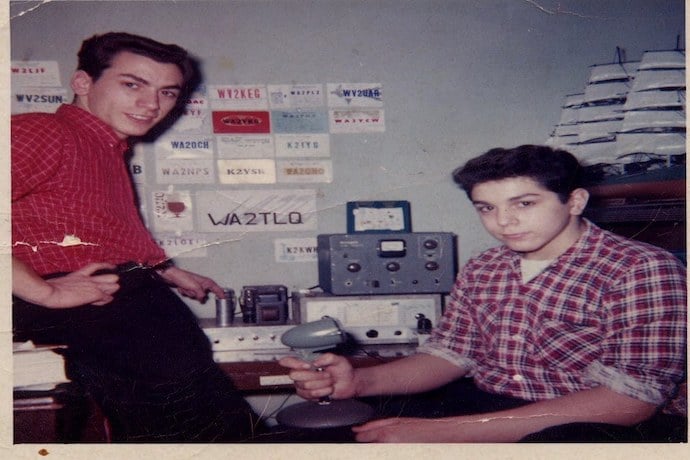If there’s any current trend in tech that I love right now it’s that people are constantly finding new ways to repurpose old technologies. Along those lines, this issue we’re going to talk about the world of people who have built an alternative internet over amateur radio.
Before we dive in, we need to talk a bit about what radio and amateur radio are. On a physical level, radio is electromagnetic waves—the same as light—broadcast out in all directions and picked up by antennas. Antennas are material, often pieces of metal, that get “shaken” by these waves in a way that creates electricity.
The electricity in the antenna can then be used for all sorts of things: for a radio station it becomes the signal that drives a speaker so you can listen to music, it can become the data that forms a webpage you access on your phone, or it can be individual frames that make up a television signal.
Even though when we say “radio” we usually mean “a thing that broadcasts music or people talking”, from the perspective of science “radio” is actually this huge range of things: your wi-fi, the cell network a phone connects to, the free tv stations that exist in a lot of places that only show fifty year old tv shows and the news. These are all kinds of radio.
We’re just constantly swimming in all these signals, this “light” that has waves so big not only can we not see them but the waves pass through us like visible light through clear glass. From the radio signal’s perspective, humans don’t even exist! It’s pretty cool, but maybe a little weird if you think about it too hard.
So if wifi is a kind of radio, have we reached the end of this article? Admittedly, it’d be pretty funny if I said “to use the internet over radio, turn on your phone” but instead we’re going to talk about something much cooler by far: amateur radio.
Amateur radio, often called ham radio, is a very old standard of communication that takes place on specific radio frequencies that have been reserved all across the world to be freely used by everyone. In most countries you do need a license to legally broadcast, but licenses generally are:
- free
- available with a very low/no lower age limit
- easy to get
When you’re licensed you also get a call sign, which is almost like an internet IP address. For amateur radio, a call sign identifies the broadcaster. It’s assigned to a person not the radio.
Ham radio is often used for people to talk to each other hundreds, even thousands, of miles apart. But that’s not all the ways amateur radio is useful.
Since ham radio is, on a physical level, the same kind of thing as wi-fi, it should be possible to convert the sound oriented radio signals into digital signals computers use with wi-fi. Then you have a reach of miles and without needing to pay an ISP for internet access.
There are a few different ways to use the internet over the radio. One of the most popular is the automatic packet reporting system (APRS), a system people have set up where everyone tunes into the same frequency and uses software or hardware to convert their radio signals into packets, just like the bits of data that get sent over the normal internet. The same way an IP address on the normal internet is used to find the computer who’s supposed to get a message, the call sign of the radio operator is used to let someone’s computer know if a packet sent out across the radio is meant for them.
APRS technology predates wi-fi entirely. People commonly set up raspberry pis to manage encoding and decoding the APRS signals and to help provide infrastructure to boost signals. People use APRS to send emails and messages, as well as sending texts cell phones can receive.
In addition to APRS, people also use mesh networks which are a little different. You create your own private network with a group of people and even use modded wi-fi routers to signal boost your radio based network. These mesh networks can be huge as your signal hops from radio-enthusiast to radio-enthusiast who have all set up routers and antennas to pass along signals, covering tens to hundreds of miles per person.
Probably the single biggest disadvantage of doing something like this is that it’s slow. Like capital-s-like-snail’s-pace slow. Like waiting for a pot to boil slow. Like don’t even think about streaming video this way slow.
And if it’s so slow, why use it? There are both practical and philosophical reasons to broadcast internet traffic with radio technologies.
The most basic reason is that it’s kinda fun to try making something like the internet with a group of friends. But also a lot of people care about this because it’s useful for disaster relief. These radio networks are slow but they’re low-power, can be maintained by a handful of people with some batteries, and still be used to keep communication going when cell phone towers go down and big areas lose power.
The last reason to broadcast the internet is that it rubs some people the wrong way to feel locked into infrastructure they didn’t make. They want to have control over it, and that makes a lot of sense to me: it’s the maker movement distilled down to include the internet we use daily.
Learn More
Global system for email over amateur radio
A very retro website on packet radio
What is ham radio?
http://www.arrl.org/what-is-ham-radio
Etymology of ham radio
https://en.wikipedia.org/wiki/Etymology_of_ham_radio
What is ham radio and how does it work?
Discover amateur radio
Amateur radio for kids
https://kids.kiddle.co/Amateur_radio
Amateur radio FAQ for parents
https://nescitech.org/amateur-radio-faq-for-parents/
How the Madey brothers made history
Beginner’s Guide to Ham radio
https://www.autodesk.com/products/eagle/blog/beginners-guide-ham-radio-make/
Why do we call a ham radio operator an Elmer?
https://www.onallbands.com/word-of-the-day-elmer-why-do-we-call-a-ham-radio-mentor-elmer/
Inspiration for the term Elmer
https://www.laselki.net/vb/showthread.php?p=57055

